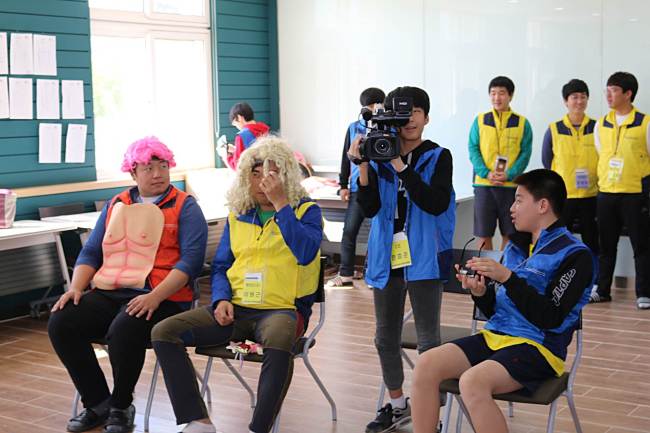MUJU, North Jeolla Province -- Located in the rural part of Muju, North Jeolla Province, the Internet Dream Village at first glimpse looks like another humble house in the countryside, surrounded by a large number of apple trees and pink garden cosmos flowers.
But the property is in fact South Korea’s only state-run institution for teenagers addicted to the Internet and smartphones. Once inside, everyone must hand over their phones to the authorities. There is no Wi-Fi service. What’s waiting for them is group physical exercise sessions, guitar lessons and art therapy classes.
The center was established last year with the support of the Gender Equality Ministry after an increasing number of teenagers were reported to be addicted to the Internet and smartphones. As of last year, 29 percent of all teenagers were at risk of smartphone addiction, while 12.5 percent were at risk of Internet addiction disorder, according to government data.
Data also showed that children of double-income families and single-parent households were more likely to develop media addiction than those with stay-at-home moms.
Since its opening, some 312 teens were treated at the center for their addiction. The duration of the programs ranges from two to five weeks. Earlier this month, when The Korea Herald visited the institution, about 12 teenagers were participating in an art class, which is part of the therapy program.
The assignment of the day was simple: Completely fill a blank piece of paper with whatever pattern or color they wanted.
“People with addiction tend to have repetitive behaviors without being conscious,” said Kim Ji-hye, a therapist who was working at the center. “This particular assignment -- filling the paper -- requires children to make choices. They have to choose what color to use, what shape they want to draw, and so on. It distracts them from forming a repetitive behavior.
“Those with serious addiction find this assignment very difficult. They either can’t stand the idea of filling the paper with something, or draw extremely small and complicated patterns.”
Kim said she has witnessed that many addicted teenagers frequently using primary colors, especially red and blue. “The color of red reflects anger and aggressiveness, while blue represents one’s yearning for security and stability,” she said.
In their play therapy class, the students were given two questions: What would you be like if you spent the next 10,000 hours playing with your smartphone? The other was: What would you be like if you spent the next 10,000 hours trying to achieve your dream?
For the first question, a 15-year-old Jeong Seong-su performed to his own script, where his muscles get paralyzed after sitting down for such long hours with his phone. “I’m dying!” he cried, while comically collapsing to the floor.
For the second question, another student wrote a script where his future self, a renowned chef, was being interviewed by a group of journalists who admired him. “You can achieve anything if you try hard!” he said to reporters as the character in the play. “I want to say that anything is possible.”
Although the students seemed to be genuinely enjoying their time at the center, it hasn’t been always easy, said Shim Yong-chul from the institution. So far, two students have dropped out of the program and gone home.
“The first three days are the most difficult part of the program for most kids, as many experience withdrawal symptoms,” he said. “Many become depressed. Some become aggressive and angry, asking to have their phones back.”
Symptoms of Internet addiction can have extremely negative effects on teenagers and their lives, according to experts. Signs of addiction include difficulty waking up for school, feelings of anxiousness when they are not online including shakiness and moodiness, sleep disturbance and having trouble completing tasks at school and home. The addiction may also lead to isolation from family and friends.
Student Jeong, who used to spend about five hours a day playing online games and using his smartphone, said one of the most memorable experiences at the center was doing physical activities with his friends.
“I just didn’t really have the time or chance to play sports outdoors. We’d mostly just hang out at Internet cafes,” he said. “What I realized is that you can still live a happy life without your phone. I didn’t think that was possible.”
According to a number of studies, the opposite of addiction is human connection, not sobriety. “Human beings are bonding animals. We need to connect and love,” writes British journalist Johann Hari in his book “Chasing the Scream: the First and Last Days of the War on Drugs.”
“But we have created an environment and a culture that cut us off from connection, or offer only the parody of it offered by the Internet. The rise of addiction is a symptom of a deeper sickness in the way we live.”
Kim Mi-jeong, who is in charge of teen addiction at Korea Youth Counseling and Welfare Institute, said statistics show that children with neglectful parents have a higher chance of developing addition and depression. “Many teen addiction cases are related to family problems. Addiction happens when you want to avoid your reality,” she said. “That is why we invite parents of the students who come here to participate in the therapy programs.”
According to Kim, who works for the center, children who received treatment at the institution tend to have a better relationship with their family members, as well as better self-control.
“The most important thing is the realizing that you have a problem,” said Park Gil-soo, the director of the center. “Many students, especially those who were forced by their parents to attend this program, come here thinking they are not addicted at all. Most of them change once they acknowledge that they in fact are addicted. That’s when they take the initiative to make changes in their lives for the better.”
By Claire Lee (
dyc@heraldcorp.com)








![[Today’s K-pop] Blackpink’s Jennie, Lisa invited to Coachella as solo acts](http://res.heraldm.com/phpwas/restmb_idxmake.php?idx=644&simg=/content/image/2024/11/21/20241121050099_0.jpg)